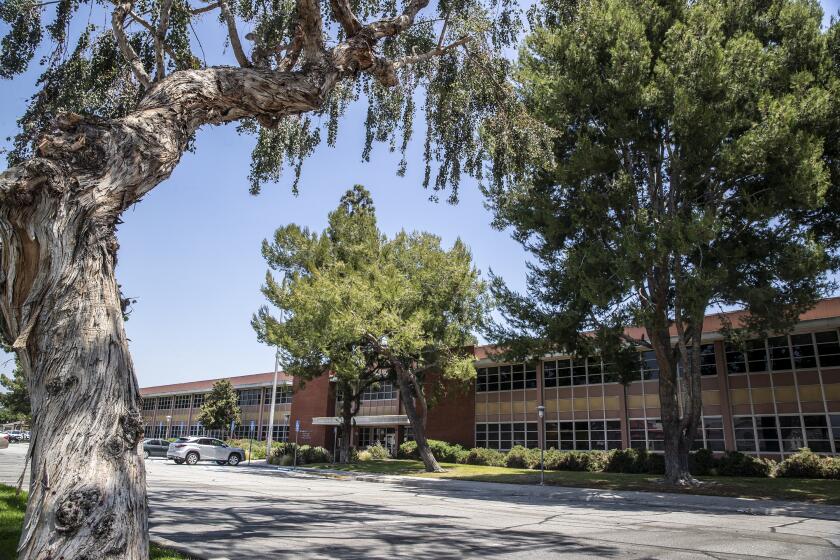Battle Over Ridgelines Heats Up in Rural L.A.
- Share via
In some ways, the northeast corner of Los Angeles is a throwback to the old West.
The rugged crests of the San Gabriel and Verdugo mountains frame chaparral-covered canyons unadorned by buildings. Residents astride horses lope along country roads. Chickens strut through dusty yards on multi-acre lots. Urban trappings such as street lights, curbs and gutters are rarities.
Many outsiders passing through this part of the San Fernando Valley on the broad, lazy curve of the Foothill Freeway have no idea that they are within Los Angeles city limits, said Elaine Brown, vice president of the Sunland-Tujunga Chamber of Commerce.
“It’s one of the few places in Los Angeles County where you feel like you’re in the country,” she said.
But in this bucolic setting, words like “meddling” and “blindsided” are being uttered as residents dig in their heels for a duel over preserving their way of life.
Brown and other community activists fear that if developer Whitebird Inc. of Nevada is allowed to build homes along the ridges of nearly 1,000 hilly acres it owns, the rural setting in Sunland, Tujunga, Sun Valley, Shadow Hills and Lake View Terrace is destined to follow the urbanized path of neighboring Glendale. “We have a lot of developers buying up property here,” Brown said.
Residents say it’s not just Whitebird’s development plans that bother them. Whitebird, in fact, has not submitted a formal development proposal to the city. What alarms them is Whitebird’s effort--which has, so far, been successful--to persuade city officials to ease development restrictions in a proposed preservation plan for the area that’s been in the works for two decades.
“As we approached our finalized plan, Whitebird got hold of it and started meddling with it,” Brown said. “They’re a real thorn in our sides.”
The plan arose from a 1998 City Council vote designating the area as an irreplaceable visual resource. The council told the Planning Department to draft development restrictions on prominent ridges visible from the Foothill Freeway and from long stretches of Big Tujunga Canyon Road, Foothill Boulevard, La Tuna Canyon Road, Sunland Boulevard and Wentworth Street.
Local residents had informally been working on such a preservation plan since 1983. At the top of their wish list was a prohibition against construction on or near ridges to preserve the natural look of the mountains.
But Brown and others say Whitebird lobbied city planners behind closed doors to reduce the protections that homeowner groups had drafted in a series of community meetings. The residents hope to persuade a City Council committee to reverse the Planning Commission’s changes before the full council votes on the plan this month. Whitebird owner Richard Percell said his company did not do anything underhanded. “We did the same thing the community did. We gave our input. We did it through professionals,” he said.
His attorney, Jack Rubens, said the community groups “completely rewrote the plan” at least twice to severely limit development.
“We were taken aback. They had blindsided us,” he said, adding that he raised only “generic concerns” with the city Planning Department while it was reviewing the plan.
Deputy Planning Director Bob Sutton said that although private meetings took place with the developer, everyone’s voice was heard. “We got last-minute stuff from everybody. We got it from all sides.”
Sutton said he changed the community’s draft to avoid the legal thicket of a “takings” issue, the term applied when developers sue because development restrictions substantially reduce the use or value of property. Courts have ruled against such limits.
But Sunland resident Greg Valencia and others said they felt duped when the Planning Commission on July 25 sided with Whitebird’s request to define ridgelines in a way that allows construction on at least one prominent crest as well as within a few feet of the top of any ridge.
“Nobody could believe it. Everyone was just in shock,” Valencia said.
A key provision sought by the community groups was a buffer zone free of any structures within 50 vertical feet of a view-protected ridge. The Planning Commission said roofs of structures whose foundations are outside the buffer zone can reach just below the crest, but residents said they thought all along that nothing could protrude into the buffer zone.
“Being able to see 5 or 6 feet of the ridgeline is not ridgeline protection,” said Bill Eick, land-use chairman of the Shadow Hills Property Owners Assn.
Steve Crouch, who heads the Canyon Area Preservation homeowner group, said he resents anyone who seeks a view from their home at the expense of the area’s scenery.
“There’s plenty of homes perched on the ridges,” he said. “And the fact is, it’s too much already.”
Percell said he’s been trying to address residents’ concerns. He reduced the scope of his plan from 375 homes to 280. He’s thinking of clustering them on about a third of his property, which straddles the Foothill Freeway at La Tuna Canyon Road, and donating the rest as open space.
“We are trying to respect the wishes of the majority of the community,” he said. “To add more constraints would prohibit innocent people from doing anything with their properties,” such as having chimneys or gazebos in the buffer zone.
The City Council’s Planning and Land Use Management Committee will review the Planning Commission’s decision Sept. 10.
Councilwoman Wendy Greuel, who represents the area and sits on the committee, supports the residents’ fight, said her legislative aide, Matt Szabo.
“The community has made it clear what areas should not be developed, and Councilwoman Greuel intends to support them on that issue,” he said.
The full council is scheduled to vote on the preservation plan Sept. 18.
More to Read
Sign up for Essential California
The most important California stories and recommendations in your inbox every morning.
You may occasionally receive promotional content from the Los Angeles Times.










